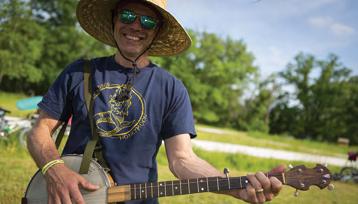THE SOCIAL ROOM
Through

















Through
















Time for a quick history lesson. In March 1917, the National Woman’s Party, a political group dedicated to women’s voting rights, was formed. In March 1972, the Senate passed Title IX, which protects people from discrimination on the basis of sex in federally funded programs and activities, and it later became law. And this March, the primary election marks nearly 100 years of white women’s suffrage in the U.S.
In this issue (where almost all content was pitched and edited by our all-female print editorial staff), in addition to celebrating local eats, artists, hangouts and events, we’re celebrating trailblazing women in Columbia and beyond.
On page 7, read about Ann Covington, the first woman to serve on the Missouri Court of Appeals and the first woman to serve on the Missouri Supreme Court; Donna Maize, the Kansas City Fire Department’s first female fire chief; and Fontella Henry, the first female African American police officer in the Columbia Police Department. On page 40, read about Mar Doering, who, at the time she applied to the MU College of Veterinary Medicine, was one of the only women to do so.
These women have faced doubt and discrimination in their fields and responded with tact, intelligence and talent. Their words of wisdom are ones to return to, especially in times of uncertainty.
The March issue also takes a closer look at an issue that affects women and their partners nationwide: infertility. On page 28, we weigh the costs of in-vitro fertilization and talk with women who have struggled or are struggling to start a family. On page 40, we dive deep into The Social Room, a place that welcomes people of all genders.
I’m inspired by women in this issue and the women I work with every day. I hope you are, too. But despite progress, there is still work to be done when it comes to gender parity in the workplace. According to the Pew Research Center, the wage gap between men and women has narrowed only slightly since 1985. Among women across all races and ethnicities, hourly earnings trail behind those of men. Asian women earn 87%, white women earn 82%, black women earn 65% and Hispanic women earn 58% of what white men earn.
It is my hope that the wage gap will continue to close. This month, I encourage you to visit the State Historical Society to see “Missouri Women: Suffrage to Statecraft,” an exhibit displaying clothing worn by women in Missouri politics before and after the ratification of 19th Amendment (p. 14), and I encourage you to be a leader and champion for equity in the workplace in your sneakers, your sweats, your business suit, your dress or your denim.
SARAH EVERETT Editor in ChiefA lot of people are part of this story about infertility (pg. 28). It was approved in fall 2018 by professor Mark Hinojosa. He constantly was pushing me and my reporting partner, Shoshana Dubnow, to find the people in this story. In the past two years, I’ve talked to about a dozen men and women. I’ve gone to their doctor’s appointments, sat in on their support groups, and visited their homes. I’m incredibly grateful for their openness to tell an all-too-common tale. If you’d like to hear more from the couples in this story, listen to KBIA’s Missouri Health Talks at missourihealthtalks.org. Sarah Hallam
EDITOR IN CHIEF SARAH EVERETT
DEPUTY EDITOR MEG DONOHUE
MANAGING EDITOR ELENA K. CRUZ
DIGITAL MANAGING EDITOR CAMERON R. FLATT
ONLINE EDITOR GABY MORERA DI NÚBILA
CREATIVE DIRECTOR HOPE JOHNSON
ART DIRECTORS SAM BALMER, MADISON WISSE
PHOTO EDITOR DEREK RIEKE
MULTIMEDIA EDITOR SAM MOSHER ASSISTANT EDITORS
CULTURE CHRISTIÁNE-TRÉSOR CRAWFORD , SARAH HALLAM , NICOLE SCHROEDER, KATHERINE STATER , EMMA VEIDT EAT + DRINK LAUREN BROCATO , BROOKE KNAPPENBERGER, LAURA SIGMUND, VICTORIA TRAMPLER CITY LIFE SIOBHAN CONNERS , MADISON CZOPEK , EMILY LENTZ, HANNAH MCFADDEN, ABBIE WILSON
DESIGNERS MITCHELL BARTLE, TAORU HUANG, CHLOE KHAW, MEREDITH LEHMAN, IVY HETTINGER-ROBERTS
CONTRIBUTING WRITERS ADRIAN BURTIN, KRISTIN BLAKE, MATT SCHMITTDIEL, VICKY TSUKANOVA, EMMY LUCAS, JASMINE-KAY JOHNSON, DELANEY EYERMANN, ASHLEY JONES

DIGITAL EDITORS JESSE BAALMAN, BRY BARGER, DELANEY EYERMANN, MOLLY JACKSON, CLAUDIA KHAW, CHRISTINA LONG, MADELYN ODEN
MULTIMEDIA EDITORS MEGAN OOSTHUIZEN, GRACE VANCE
EDITORIAL DIRECTOR HEATHER LAMB
DIGITAL DIRECTOR SARA SHIPLEY HILES

EXECUTIVE EDITOR JENNIFER ROWE OFFICE MANAGER KIM TOWNLAIN
Vox Magazine @VoxMag
@VoxMagazine
ADVERTISING 882-5714
CIRCULATION 882-5700


EDITORIAL 884-6432 vox@missouri.edu
CALENDAR send to vox@missouri.edu or submit via online form at voxmagazine.com
TO RECEIVE VOX IN YOUR INBOX sign up for email newsletter at voxmagazine.com

MARCH ISSUE 2020
VOLUME 22, ISSUE 3
PUBLISHED BY THE COLUMBIA MISSOURIAN 320 LEE HILLS HALL COLUMBIA, MO 65211
MAGAZINE
CORRECTION: Antoine
is from the Republic of Congo. An article in the True/False issue misstated his home country.
Cover Design: Sam Balmer

Be yourself; be different; be social. The Social Room’s motto invites people from all crowds, and the LGBTQ community has found a home on the disco-lit dance floor.
BY HANNAH MCFADDENEveryone knows raising children is expensive, but for some people, that cost begins with trying to have them.
BY SARAH HALLAM7
Ladies first
Three Columbia women have shattered glass ceilings in the court, the firehouse and the police department. 10


Why
A European perspective on American discourse (or lack thereof).
14
A seasonal Logboat brew, lovable new coffee shops, an ode to women’s history and more of what we’re enjoying this month.

Local indie rock band Fumes looks forward after celebrating its fourth album’s release at Cafe Berlin.

17
A picture of Boone’s past
Boone County celebrates its 200th birthday with a mural that pays tribute to local treasures.

18
Rock ’n’ rap
Tune into local bands and artists such as Conman Economy, Jay Wood and loose loose.
These three Missouri women made history in their fields.
 BY KRISTIN BLAKE
BY KRISTIN BLAKE
March is Women’s History Month, making it the perfect time to introduce you to three local women who have broken glass ceilings and racked up firsts within Missouri’s justice system and police and fire departments. Despite the strides made over the years, gender equality and parity in the workplace often remain out of reach. Data from the U.S. Census Bureau indicated women make up only 3.9% of firefighters, 13.6% of police officers and 47.4% of judges and magistrates as of 2017. They were often underrepresented in their fields, but these women moved Missouri forward.

Fontella Henry — police officer

Glass ceiling shattered: Henry became the first female African American officer in the Columbia Police Department in 1982.
Inspiration: Growing up in St. Louis, Henry looked up to her uncle who worked as a police officer and detective in the city. “As a child, I really admired him,” Henry says, adding that she went to school and pursued a criminal justice major with a minor in psychology. “So I knew that was the route I wanted to go in the criminal justice field.”
Proudest achievement: Henry was a D.A.R.E. officer at several Columbia schools. To her, this program dealt with more than the topic of drugs; it was about teaching students how to be confident, how to say no and how to make good decisions. She loved that she was able to leave a lasting impact on students’ lives.
On being a woman in her field: In her career, Henry has noticed how men
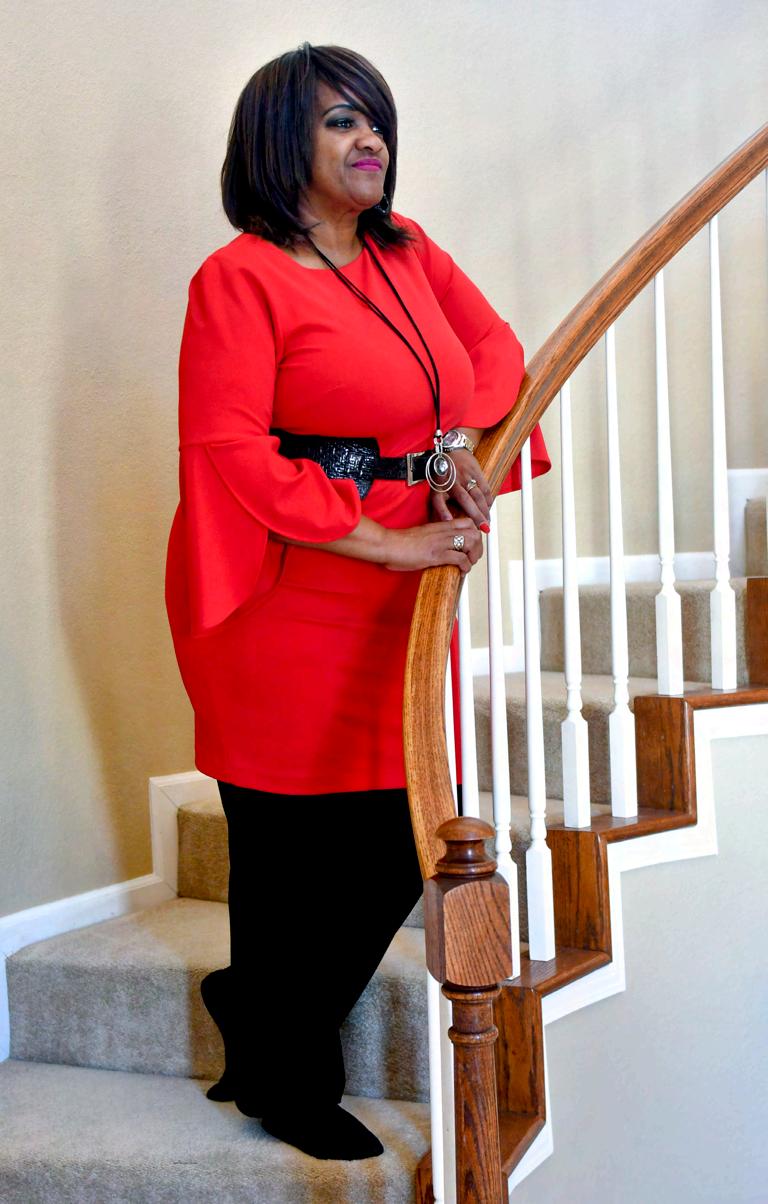
underestimate and think they’re different from women. She says one of the most difficult things to accept is that “you’ll never be a man.” For this reason, she says women need to learn to play to their strengths. “We have the power of being able to think and to talk through most things with people,” she says. “You can reason with people more so than just taking them to the floor every time or taking your gun out and shooting people.”
Henry has faced discrimination on the job including being called racial slurs, she says. One day, a field training officer told her the other men at the station gave him condolence cards because he was in charge of training her. “He just tried to kill my spirit,” she says. “But it didn’t happen.”
Favorite career moment: When Henry worked on the investigative unit, she handled a case of a girl who ran away and was missing for weeks. With the right tips and some determination, Henry was able to locate her. Henry says the mother was horrified that her daughter ran away, and she hadn’t seen any red flags for such behavior. The memory is special to Henry because she helped a worried mother. Henry still runs into this mom and asks her to say hello to her daughter. Best advice: There aren’t boundaries anymore, so don’t let anyone limit who you are, Henry says. “You can break that glass ceiling. I’m telling you, it does not exist anymore,” she says. “It’s gone. Go for it, girlfriend.”

Glass ceiling shattered: Covington was the first woman to serve on the Missouri Court of Appeals, Western District after being appointed in 1987. In 1989, she became the first woman to serve on the Missouri Supreme Court. She was also the first woman to preside over the court as chief justice, a position she held from 1993 to 1995.
She stepped down from the court and returned to private practice in 2001 and eventually retired from practicing law in 2010. She remains active in the community by being a member of the Stephens College board of trustees, staying involved at her church and serving as
a trustee for the State Historical Society of Missouri.
Inspiration: A native of Fairmont, West Virginia, Covington says she never planned on going to law school and ended up there “by default.” She had planned on earning a Ph.D. in English, but she felt the job market was already saturated. “I thought, finally, what can I do that might help other people?” she says, adding that she wanted to study something interesting that would also help her get into academia. “And so I settled on law school without any idea of what I might ever do.” Along with her acceptance letter from the MU School of Law, the dean wrote to Covington and suggested it wouldn’t be possible for her to succeed at being both a mother and student. She disagreed. At age 32, with two children, Covington started law school. She graduated in 1977.
Proudest achievement: Covington is proud of her mentorship of younger legal professionals and the one-on-one relationships she developed with her clients. “I hope that I was able to help other people while still being a good, strong lawyer,” she says. “It really meant a lot to me to be able to do that.”
Ann Covington’s achievements have been recognized many times throughout her career. In 2019 she was honored as one of the American Bar Association’s Women Trailblazers in the Law.

On being a woman in her field: Covington says the hardest part is “proving oneself to be as capable as anybody else.” She has experienced everything from being patronized with pet names to being mistaken for an attorney’s secretary. Covington felt these moments were not due to malice but to a “lack of enlightenment.” At first, she tried to ignore it, but eventually Covington developed a customary response that’s gentle but conveys her point. She asks: “Isn’t there a better way to say that?”
Donna Maize says it’s important for women to find their confidence, their voice, “and stick up for what they want to do and follow that path, whatever it is.”
Favorite career moment: In 1994, Covington took part in a historic moment for Missouri. Under the Missouri Constitution, if the House of Representatives impeaches a state official, the Supreme Court acts as a trial jury that hears evidence and decides whether to convict. Judith Moriarty, the secretary of state at the time, was convicted for misconduct and removed from office. As chief justice, Covington led the court through the proceedings. “That is quite a remarkable historic event, not only because it has just happened once, but also because it’s such an unusual process,” she says.

Best advice: Do something you love, try to be the best you can be and work harder than everyone else. “When you perceive that you’re invisible, don’t give up,” Covington says. “You can still be a lady and be strong; you can be a steel fist in a velvet glove.”


Glass ceiling shattered: In November 2019, she became the first female fire chief for the Kansas City Fire Department.
Inspiration: Maize was inspired by her dad, she says. Five years before she was born, her father joined the fire department. Decades later, she’d grow up to fight fires alongside him in her hometown, Kansas City.
Proudest achievement: She gained the respect of her peers. Of 1,000 first responders, only about 35 were women when Maize first joined the Kansas City Fire Department. She remembers the male-dominated atmosphere exuded doubt over whether female counterparts could keep up. Maize says things started to change even with “some of the hardcore, die-hard male firemen” once she started working alongside her male co-workers and they really got to know her.
On being a woman in her field: She says it’s challenging to speak up, be ignored and face patronizing responses. Women are not taken seriously in their work at times, so there is a need to prove themselves as knowledgeable and in control.
Favorite career moment: While serving as deputy chief of special operations, Maize did everything from ride rescue boats on the river to help with the World Series parade. “There are cool events that have such a great impact on the whole city that are fun to have that bird’s-eye view,” she says.
Best advice: Trust your instincts. Have courage and confidence. She says it’s also important to find your voice, stick up for what you want and follow that path, wherever it leads.

 BY ADRIÀN BURTIN
BY ADRIÀN BURTIN
Summers feel long in the Southwest of France. From about 2005 to 2015, my aunt Véronique lived in an old creaky house next to the cemetery in a calm, typical French village. At night, we would set the table in the garden and eat melons and French delicacies. On some occasions, the grown-ups would open a bottle of wine. Dinner would sometimes go until 1 a.m.
When dinner would take too long — usually because the guests had been talking for hours without showing signs of fatigue — I would leave the table and play in the old garden as the sun slowly descended behind the hedges.
Closing my eyes, I can still hear the bats squeak, the cobblestones sing
below my feet and the tired voice of my aunt in the dark: “No, you can’t say that!”
My family loves arguing. Call it a common character trait or a psychological deviance, the fact remains that every single one of us likes to quarrel on any topic we find fit. Honestly, we might even feel some pride in it. Conflict can come from any discussion with us: town rumors, personal anecdotes and, of course, politics. My family has always enjoyed a good ole’ clash of ideologies, probably due to our historical background — Grandpa was a Communist and has tried (and failed) to pass that on to his children — and also due to the way our family expanded, left town and settled in different places with
different jobs and different concerns. Conversations about government, laws, and what’s right and wrong have long been part of my family-dinner experience; a strange party is one spent without a political interlude between two beers. This isn’t to say that every night looks like a democratic debate, but being stuck between my aunt, who is a left-wing school teacher, and my brother, who would have gladly enlisted in a nationalistic military, teaches you to have curiosity about others’ opinions.
My stay in Columbia was my first time in America. I came to study journalism at MU for a semester. I was intrigued by what I was going to see and hear. I
mean, a country built on colonization, a country led by one of its most controversial and polarizing presidents of all time, had to be a place of turmoil and political fervor. It was going to be insane.
But in truth, it was far from insane. It was mundane, even. Polite and mundane. It took me some time to realize that Americans are trained in chit-chat but avoid certain topics. Most of them love to argue about the best food, the best place to live or the best bars. But politics, and social issues in general, are often left out of discourse. From people willingly ignoring poverty in their own towns to political science teachers doing anything to avoid heated debates during class, it seemed to me that Americans had a problem with discussion.
After trying to get to the bottom of this in conversation with my friends, I was left with the feeling that Americans live by an unspoken agreement, one which isn’t hidden behind facts or statistics, but behind a behavior code, implied in every word, sentence or topic. In a country where everything has
gone to hell, one ought not to talk about the rising heat.
“I think what you’re witnessing is this form you have in the Midwest,” says Chris Conner, visiting assistant professor of sociology at MU. “It depends on where you’re located. I spent this summer on the East Coast, and people were definitely engaging in those conversations at pubs and bars, as what you’d see in Europe.” Because of this tendency, or Midwest politeness, people don’t want to say anything that might be offensive or taken out of context, Conner says. So maybe what I was experiencing wasn’t a wholly American phenomenon. I might have just ended up in the least confrontational part of the country.

That being said, studies show that Americans in all regions are skeptical of political small talk. Take studies about the secular Thanksgiving as an example. In 2018, UCLA behavioral economist Keith Chen and Washington State University Ph.D. student Ryne Rohla


Burtin says heated political debates are a mainstay of his family gatherings.

used smartphone data to measure travel times during the holidays. They found that people were less likely to cross into conservative and liberal states. In other words, Americans are willing to avoid loved ones to avoid conflict.
However, politics are the bed bugs of social interaction: They will always find their way into your home. Research by Greater Good Magazine shows that there seems to be a correlation between political



polarization and aversion to conflict. When it comes to politics, fear of confrontation is leading people to tune it out rather than talk it out. We can say that this deep fracture between American citizens creates, or at least feeds, the difficulty of political conversation.
Through geographical and psychological processes, we can find a lot of reasons why people don’t talk with one other. There’s a growing polarization of voters around the country, a concerning separation between rural and urban areas (implying that we only talk with people from the same background) and a clash between generations. Sherry Turkle, a bestselling author who writes about technology, explains social media can be another roadblock to productive conversations. Young people are heavily influenced by social media, she writes, and the confirmation bias that comes with it. They’ve never had the incentive to have difficult face-to-face interactions.
In other words, people seek out other people who are similar to them,
which leaves little room for ideological debate. It seems we’re in a conversational dead end. “Instead of engaging someone in a conversation about ‘Why do you think that way?’ what is happening is both parties decide to tune out,” Conner says,“because it is psychologically uncomfortable to have those conversations.”
But there’s another problem. “I think people don’t want to talk about race issues, for example, or even the overcrowding in jails. We’d have to talk about the underlying racial problems, and we’d have to talk about how the system is structured,” Conner says. “People realize that, if they want to confront issues, they’d have to confront the structure of society and how it’s been shaped to favor a particular kind of individual.” Discussing and addressing political issues would mean dismantling an entire system as well the way we think and the way we’ve been shaped by society.
I believe a lot of people must feel that way. Politics are too complicated, and they touch too many issues, and politicians aren’t representing people effectively, so how can things ever change?
The first step of understanding politics is, in my opinion, realizing how much of a pragmatic, lesser-evil game it is. It’s
impossible to please everyone; even the most genuinely positive action can bring anger. It’s no wonder people feel disconnected from the process and their leaders. But we can’t avoid politics forever.
Why do we have to be pessimistic about our ability to change what’s happening around us? Talking about conflict means confronting it. Because it’s a big, cold and incomprehensible machine? Fair enough. But the system is human-made, and it only takes humans to tear it down.
If the problems we’re facing are connected to the very foundation of the nation, can we ever overcome them? Nathan Katz, a doctoral candidate in the MU sociology department, is skeptical. “I don’t know, and I don’t know if we’re better off solving them,” Katz says. “Using the climate change example, are we better off having a state of ideological unity and discussion that treats climate change as if it’s not a thing? Unity to move forward is a good thing, but if we’re not going to be able to move forward in a way that’s based on scientific data to make decisions or, simply move in the right direction, are we better off at a standstill than moving in a negative direction?”
If that’s the case, then why even bother talking if sitting at the same table runs the risk of us going in the wrong direction together? Thinking

IT TOOK ME SOME TIME TO REALIZE THAT AMERICANS ARE TRAINED IN CHIT-CHAT BUT AVOID CERTAIN TOPICS. MOST OF THEM LOVE TO ARGUE ABOUT THE BEST FOOD, THE BEST PLACE TO LIVE OR THE BEST BARS. BUT POLITICS, AND SOCIAL ISSUES IN GENERAL, ARE OFTEN SWEPT UNDER THE RUG.
– Adriàn Burtin
this way, the safest move would be to not make a move at all. Maybe that’s the case. But we have to see politics as something in perpetual motion. Even if we avoid getting involved in order to preserve the status quo, others will make us move — potentially in the wrong way. Making a move is necessary, and I believe that the good direction is always a choice. Politics are driven by people; we need to have faith in them — in us.

Some people never learn from others’ insights. They learn by themselves; they make their own ways, meet people and reflect on their own regardless of anyone trying to push ideas down their throat. This doesn’t mean we should ignore them. Talking and listening will always be the cornerstones of political maturity.
There’s no need to be a prophet to those who are against you; being a reasonable human usually does the trick. I had a Catholic religion teacher in high school who used to tell me: “Look at the Bible. Jesus spent most of his time eating at a table, surrounded
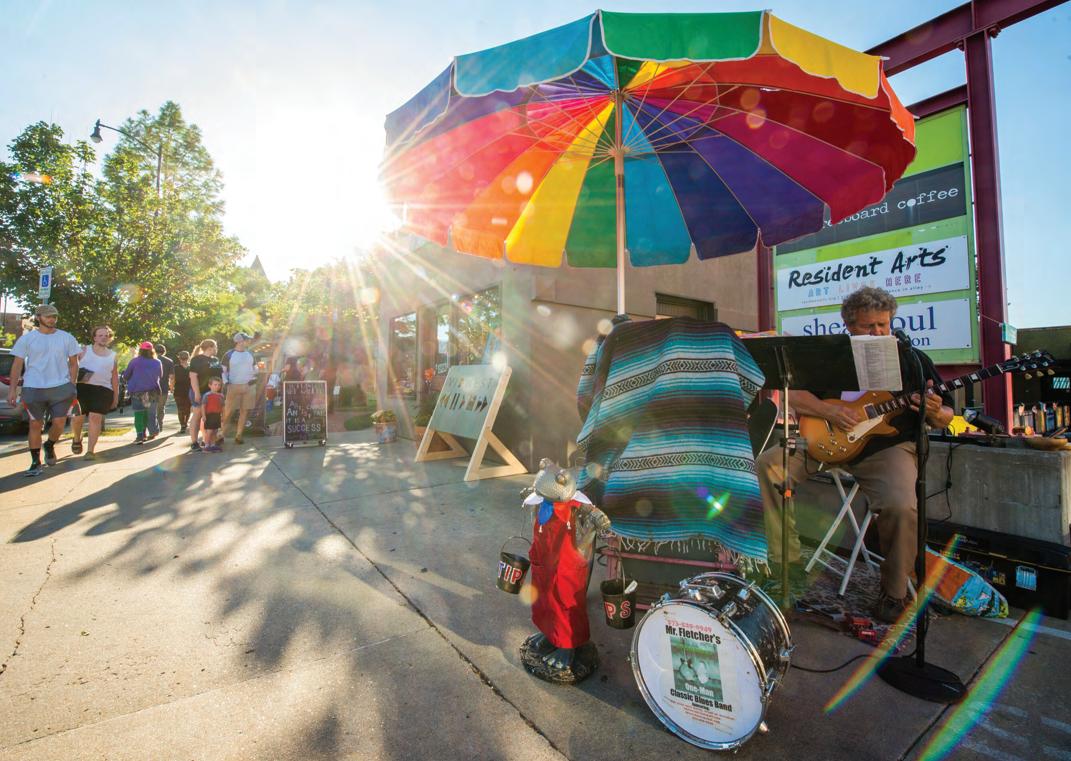

A quick Google search of “how to avoid politics at Thanksgiving” produces more than 11 million results, including articles from NBC News, The Atlantic and People magazine.
by his friends.” He spent much of his time sharing meals and having tough conversations with people he had little in common with. A few centuries later, the same guy now has millions of followers around the globe. Behold, the power of a regular dude.
When I was 8 years old, I moved to a small apartment in East Brussels with my brother and mother. My mother had cut the last connections she had with France. My brother, a teenager at the time, was devastated that we moved and that he had to leave all his friends behind. Family dinners at the time were like having a picnic surrounded by landmines. Each word had to be carefully weighed because it would almost certainly start a fight between those two. I vividly remember my mother sobbing in the kitchen’s door frame after another confrontation; her puffy face was highlighted by the white neon lights above her before she realized she was crying in front of me and immediately hid in the kitchen.
My family loves arguing. Maybe it’s a character trait, but it also could be a natural tendency to express out loud the fact that none of us get along.

Coming to Missouri, I took pride in my ability to express opinions and found ridiculous, ironically, the discomfort of others to do the same; to do something I learned from decades of family feuds. Now, I’m not sure I can brag about that argumentative nature anymore (though I could certainly talk to an expensive therapist about it). Even though I still firmly believe that expressing your opinions matters now more than ever, I see the intricacies that lead people to avoid certain topics.
Why don’t Americans talk about politics? Maybe because they worry about making enemies of their family and friends. Maybe it’s because they know their country is a ticking time bomb, and scratching the match between dinner and dessert won’t help. Maybe they just want to enjoy some calm before the storm. Is that wrong? No, probably not.
Each month, Vox curates a list of can’t-miss shops, eats, reads and experiences in and around Columbia. We highlight the new, trending or criminally underrated — so you’re always informed of the best our city has to offer
BY KATHERINE STATER

Three books by Missouri authors. Everywhere You Don’t Belong by Gabriel Bump features Columbia as one of the main settings and was written by a former MU student. The story follows a young boy as he tries to find his place in the world. Faster by Neal Bascomb, a St. Louis native, tells the story of a Grand Prix racer and his team as they attempt a symbolic defeat of Hitler. TaraShea Nesbit, who earned her master’s degree from Washington University in St. Louis, published her latest book, Beheld, which revisits the first murder in the pilgrim colonies through the eyes of two women whose voices previously went unheard.


Logboat’s seasonal beer — Flybye, a saison-style with a dry, tart and fruity flavor — is a refreshing springtime taste for fans of the local brewery. Logboat uses Pilsner malt, oats and dry wheat with a Belgian yeast for fermentation, and Flybye sits at 5% alcohol content. The beer comes in a bright-blue can with an image of a green alien riding a rocket in the center. With St. Patrick’s Day upon us, there’s no better time to enjoy a good drink with some good friends. Get it while you can: The seasonal brew is only available until May. $5/pint, $10/6pack cans from Logboat Brewing Co. Taproom, 504 Fay St., and for various prices from other local venues

In honor of Women’s History Month and the 100th anniversary of the 19th Amendment, the State Historical Society is collaborating with the Missouri Historic Costume and Textile Collection for “Missouri Women: Suffrage to Statecraft.” It is an exhibition displaying the clothing worn by suffragettes and trailblazing women in Missouri politics before and after the ratification of the 19th Amendment. March 14 through July 25, Tues. to Fri., 8:30 a.m. to 4:30 p.m.; Saturdays, 8:30 a.m. to 3 p.m., State Historical Society of Missouri Center for Missouri Studies, 605 Elm St., free

Your caffeine addiction at one of three new additions to the Columbia coffee scene. Sitting across from Hickman High School at 1009 N. Providence Road, Aroma Coffee House recently had a mural painted across the ceiling to decorate the space (but don’t worry — the paintbrushes are kept safely away from your delicious coffee). Three Story Coffee branched out from the Jefferson City area to make a new home at 300 N. Tenth St., Suite 100, in early January. The shop buys from farmers and producers that the owner has visited. Newest to Columbia, Love Coffee gives work experience to those with barriers to employment at 15 Business Loop 70 E. Get a lot of coffee for a little money with bottomless drip-brew coffee at just $2.75.
Lou Nevins’ latest project is as eccentric as it is introspective.
BY VICKY TSUKANOVAColumbia musician Lou Nevins has played in a lot of bands in his life, but none are as personal and close to his heart as Fumes. The indie rock music project is the brainchild of Nevins, and In My Skin, Fumes’ fourth studio album, was released in November 2019. The band is made up of his friends Stella Peters, Charley Waddill, Andy Rehm, Travis McFarlane, Brock Johnson and Tony Zager. Different artists are featured on each album. Nevins talked to Vox about the songwriting process for this album and what went into the February album release party.



First there is a spark
Nevins is the lead vocalist and guitarist of the group. “I was always just enamored by people who play music,” Nevins says. Growing up in Columbia, his parents played music around the house and took him to live shows. Hearing music on

an intimate level early on made Nevins realize that if others were doing it, he could do it, too.

The newest generation
Nevins says Fumes is a name with more than one meaning. Exhaust fumes, vapors or reflections of anger are all within the realm of possibility. Much like the multilayered name, each album Fumes has re-
corded has featured different musicians. Wil Reeves owns Centro Cellar Studio near Business Loop 70 and has recorded most of Fumes’ songs. He’s also seen firsthand all of the different musicians to play in Fumes over the years. “Initially, these are songs written in a certain way that gives it legs to evolve,” Reeves says. “But Lou himself has certainly evolved; the cool thing with Fumes is incorporating Stella into it.”
Stella Peters is the newest addition to the group. She and Nevins met at a karaoke bar, and Nevins asked if she’d like to be on the album. “It’s almost like her voice was always meant to be there,” Reeves says.

Fumes is a departure from the other bands Nevins has been in. He describes his past bands as much more rock ’n’ roll while Fumes has a more mellow sound. This band is also the most personal project Nevins has worked on, and he describes the songwriting process as
a sort of self-therapy. The title track, “In My Skin,” is a slow-burner of a duet, with goosebump-raising lyrics like “It’s OK if you kill me as long as you wear my skin.” In contrast, the album opener, “Them All,” is an upbeat ballad about embracing one’s feelings.
Although Nevins has played hundreds of shows in his life, Fumes only started to play live in the past year. Nevins says Fumes has played about 10 shows in Columbia, mostly at Cafe Berlin and Cooper’s Landing. The band’s album release party was at Cafe Berlin Feb. 28, a comfortable and familiar (and available) venue for him. Concert-goers got their own copy of a CD and a digital download for going to the show. Fans old and new crowded in front of the stage and swayed along to the new songs.
You can stream In My Skin on Bandcamp now. If you missed the album release party, no worries. Fumes’ fifth album is already underway.
A new mural at the Boone County History and Culture Center brings mid-Missouri’s history into the present.
BY EMMY LUCASWithin the Boone County bicentennial mural, Tom Bass trains a stallion in one panel as bikers ride the Katy Trail in another. Painted streams flow down the panels and connect to an image of the Missouri River. “It’s basically a treasure map,” says Stacy “Wildy” Self, the owner of WildysWorld! MuralMakers Studio and the mural designer and facilitator.
The Treasures of Boone County mural is part of the county’s 200th birthday bash. “We’re going to have a birthday party, but a birthday party ends, and you might have a memory of it, or you might have a T-shirt, but it’s not something very permanent,” says Boone County District II Commissioner Janet Thompson. The mural is a way for the celebration to last.
The mural is 16 feet by 20 feet and divided into eight puzzle piece-shaped plywood panels. It mimics the shape of Boone County, with each section representing one of eight larger towns. The mural will be displayed at the Boone County History and Culture Center until the end of 2020 when each piece will be returned to its respective community.

Although Self designed the mural, making it was a community effort. All of Boone County was invited to brainstorming sessions and community paint-
ing nights beginning in March last year to make their mark, and hundreds of people participated. “It gets the public involved in a historical moment,” Self says.
Self and Thompson say the mural can’t include every treasure, but it captures quite a bit. “It’s looking at who we are, and it can’t express all of who we are but should at least give people a flavor of what formed us,” Thompson says. Here’s a look at which pieces of the past locals chose to represent their communities.
Ashland: Residents painted the town’s downtown and general stores this past October. Dating back to 1853, Ashland is also represented on the mural through nature with the Three Creeks State Wildlife Area and Mark Twain National Forest.

Centralia: This portion features Centralia’s Chance Gardens and the Pinnacles, which spans across four communities on the painting: Centralia, Harrisburg, Hallsville and Sturgeon.
Columbia: The columns stand tall, the Missouri Theatre shines bright and locals dance in Stephens Lake Park. Columbia’s section also features its vibrant city life, including The Blue Note and produce for sale in the Columbia Farmers Market.
Hallsville: Just 15 miles northeast of Columbia, Hallsville is named after pioneer citizen and postmaster John Hall. The post office, Finger Lakes and Red Top Christian Church are scattered through this section.
Harrisburg: A herd of cows dot the fields in this piece as a reference to Harrisburg’s cattle industry. Champion fiddler Pete McMahan also makes an appearance, along with the railroad that brought people to the region in the 1800s.
The bicentennial mural was still in progress as Self worked in her studio in February. The references to county history and culture are easy to spot. Note crossing guard and police chief Lyn Woolford on the Ashland panel (left).
The mural will be on display at the Boone County History and Culture Center from March 12 through the end of 2020. Afterward, individual pieces will be returned to the communities they portray.
Rocheport: Grapes are featured along the riverbank to pay homage to local agriculture and Les Bourgeois Winery. The community’s sandbagging efforts from previous floods are shown on the piece as a symbol of the area’s resilience.
Sturgeon: This piece represents how transportation allowed people of different backgrounds to make mid-Missouri their home, from the settlers who came by railroad to the Amish communities living there today.
The Missouri River Community: Across the mural, streams highlighting the county’s interconnectedness flow into the Big Muddy. Missouri River Relief executive director Steve Schnarr says he enjoyed helping paint a piece of history. “There are so many communities that are right along the Missouri River in Boone County, and those are some of the oldest communities in the county,” he says.

 BY MATT SCHMITTDIEL
BY MATT SCHMITTDIEL
It’s time to update your playlists. Take a break from your usual rotation, and discover new artists who are right here in Columbia. These three artists should be on your radar for spring.
This Kirksville band made a name for itself in Columbia after winning the Band of the Year title at the 2019 Mid-MO Rock Awards Show. “We kind of threw a pebble here in Columbia, and since then, we got a ripple effect,” singer and guitarist Anthony Brummer says. “It’s a really great feeling to go from relatively unknown to band of
the year.” The band mixes hard rock and pop-punk with a dash of metal, and its killer vocals and pulsating rhythms shine through. Brummer says the band’s recent success comes from hard work and their character. “We are loving with each other and anybody that comes to our shows and anybody that doesn’t come to our shows,” says Brummer.
“It’s just the way we like to be ... to be a light in this dark world.” You can catch the band coming out with some new singles this year and a potential tour in the spring.
Press play on these: “Tonight, Tonight,” “Can’t Hold Me Back” and “Walk Away.”

loose loose is a Columbia-based band that doesn’t stick to one particular genre. In 2019, the group released its EPs sanguine and CANDOR
The Chicago native who now calls Columbia home performed a sold-out show at Cafe Berlin in November and says he felt like he finally made it. “I got up there on the stage, and it was a dream; it was amazing,” the rapper says. He says he wants to be a Renaissance man of music by combining his different inspirations from artists such as 50 Cent and Earth,
Wind & Fire. In other words, Wood says he will “take the best of it all and then put it into one package.” His honest, bold lyricism and confidence on stage transform his performances into an experience. The rapper intends to drop a few singles this year and hopefully headline a show at The Blue Note in the future. Press play on these: “Come Scoop,” “Destiny” and “Food for Thought.”

Conman Economy is a hard-rock-meetspop-punk band. The group will perform at The Aquadome in Kirksville March 28. loose loose


What started as an instrumental jazz fusion project has turned into a dynamic local musical group. If you’ve ever seen loose loose live, you’ll probably agree the band is “tight tight.” The seven-piece band draws from diverse musical backgrounds including jazz, soul, R&B, hip-hop, metal and everything in between. Its music style is loose because it has no boundaries. “When we say future soul, the key word really is future,” drummer Jacob Somerscales says. “We try to look forward, always.” If you are into instrumental solos with breathtaking vocals and melodies, this band is for you.
Press play on these: “ spacelung,” “shoefits” and “feel the love.”
What started as a speak-easy became a safe haven for self expression. It’s more than a place to dance and drink. The Social Room offers a respite for everyone to be themselves.

Going to The Social Room is like visiting Wonderland: You get there through the looking glass. From outside the one-story brick building on Eighth Street, a yellow banner reads: “Be yourself. Be different. Be social.” If you look through the left window, you can see a cafe washed in red light. The eatery and the club are separated by a mirrored wall. It might seem silly to push on a mirror in a nightclub, but have faith. It’s actually a door that swings into a hallway illuminated by lights that look like the Super Mario Bros. video game mystery boxes. On the right, the hallway leads into a game room with a pool table and three retro Nintendo consoles with a rotating selection of games. Vinyl records adorn the walls. On the other side of the hallway, you’ll find a dance floor illuminated by flashing lights, silver streamers and
a glittering disco ball. Tucked away at the end of the hall is a nook decked in a gold sequin curtain. It’s a small spot, but it makes the perfect photo backdrop. The bright teal and yellow walls, sparkling glitter and nostalgic gamer decor combine with the lights and swelling music to amp up the whimsical feeling.

For many young LGBTQ people in Columbia, The Social Room really is a wonderland.
You won’t find any listing that says The Social Room is a gay bar. It isn’t. Still, people of all identities and sexualities flock there in droves; it’s a place where everyone can be themselves, however they see fit, and feel safe to party on.
Columbia has held pride events since the 1970s, and in October, it became the first city in Missouri to ban conversion therapy on minors. How-

ever, prejudice still exists. In 2015, the Missouri State Highway Patrol reported 80 known victims of hate crimes due to sexual orientation. Statistics like these highlight why safe spaces for the LGBTQ community are important in any city.
Columbia’s downtown bar scene caters to beer geeks, wine snobs, sports nuts, MU fanatics, concert junkies, Greek townies and karaoke crooners. The Social Room’s customer base is what owner Jesse Garcia calls “the everybody else crowd.”
“It doesn’t matter their sexual preference or whatever,” says the club’s general manager Adam Mordica. “Everybody has their cliques, and we have ours. We’re the everybody clique.”
The Social Room will celebrate its fifth anniversary this April. When it opened in 2015, Garcia wanted it to be a speak-easy venue for live, local music. Customers entered the bar from Lips and Curls Salon on Eighth Street. Once inside, they had to pick up a telephone and whisper the password to a bouncer on the other end of the line to gain access to the club.
The Social Room’s live music days came to an end in 2017. “It just got to be too costly to continue,” Garcia says. “We got to talking about what needs down-
town weren’t being served. Instead of live music, we went for a counterculture.”
That March, Dirty Disco found a home at The Social Room. This weekly indie dance party, previously hosted at Eastside Tavern, drew a lively crowd, and The Social Room steadily grew in popularity, Mordica says. Now, the Friday night line for Dirty Disco sometimes wraps into the parking lot behind the building. Over the summer of 2017, Lips and Curls Salon was turned into a kitchen and eating space for The Social Room.
The opening of the club came at a time when the LGBTQ community needed a place of its own downtown. SoCo Club served that need until it closed in February 2015. Just two months later, The Social Room opened, and the displaced queer night scene from SoCo Club made its way to Eighth Street. The theme nights, such as Emo Night and the Hi, Hello, Welcome comedy night, pull in plenty of fans, but they’re more than that. There’s a welcoming feeling under the flashing lights of the dance floor and in the surrounding rooms.
Jon Beltrano, a 23-year-old MU alum, remembers anxiously asking everyone in line what the password was before going into The Social Room for the first time in 2017. Password use had been
retired earlier that season, but Beltrano still remembers what the other customers said it had been: “rock-a-torium.”

“It felt like a rabbit hole into this place you never think Columbia could have,” Beltrano says. In 2018, Beltrano moved into a house two blocks from The Social Room. He knew it was the only place he would go out; it was the only place he could be his most authentic self.
After the SoCo Club closed in February 2015, Columbia’s LGBTQ community needed a refuge downtown. The Social Room opened two months later and welcomed all patrons. In true speak-easy style, the club required an entry password, which was retired in 2017.
“I felt like I could vogue there,” Beltrano says. Voguing is a style of dance that was popularized in the ’80s by black and Latinx LGBTQ communities in New York drag balls. At other clubs, Beltrano saw smartphone cameras track his movements if he tried voguing because of how different and distinctly “gay” the dance was. He says he found this demeaning, as if people were reducing him to a caricature of gayness. He doesn’t have that problem at The Social Room. “I wouldn’t get weird looks,” Beltrano says. “It just felt like people were fully inviting me and kind of pushing me to do it, too.”
Newcomers to Columbia find a kind of comfort at The Social Room, too. Belle Smith, from Mexico, Missouri, didn’t particularly like going out. She tried Columbia’s sports bars and clubs, such as Fieldhouse and My House, but something wasn’t sticking. “I’d just kind of stand there,” she says. “It wasn’t really my scene.”
Smith went to The Social Room for the first time last summer. As a bisexual woman, she was drawn in by the feeling of acceptance. On the dance floor, Smith could shake off her introversion. For the first time, she felt comfortable enough to dance in front of others. “It was kind of my escape,” she says of her initial experience. “And then I found all these people; it just became like my home.”
It’s what inspired her to permanently move to Columbia. “If I had never gone to Social, I’d probably still be in Mexico, Missouri, with my dad, just doing my thing there,” Smith says. “This feels like all I have, and that’s all thanks to Social.”
Now, Smith visits The Social Room regularly to see her friends. Some identify as part of the LGBTQ community,
tooed on her bicep. It was a gift from Garcia. He paid for it on the terms that he could film Michno getting the tattoo for the bar’s social media. The ink symbolizes her self-love, her sexuality and the place where others accepted her. “That’s why I’m never going to be embarrassed about my tattoo,” she says. “It’s meaningful to me.”

But The Social Room doesn’t exist in a vacuum, and the possibility of danger comes in the door with any patron. That’s why being proactive is important.
Mordica says the common value of acceptance makes The Social Room the spot for the LGBTQ community to feel safe while having a good time. “We see any kind of bigotry going on or harassment, we put that down super quick,” Mordica says. He compares bar safety to going to a house party with friends. You’d expect your friends to have your back, and that’s what the staff
members at The Social Room strive to do for their customers.
“You never know who’s going to get in there and do something,” Michno says. “Overall, the climate and the environment that The Social Room creates is safe.”
When it comes to bar safety, being observant is essential. “Reading people and body language is a real thing,” Eastside Tavern owner Sal Nuccio wrote in a Facebook message to Vox. He says the LGBTQ community has been present at Eastside Tavern since 2004 when he put a large rainbow sticker on the bar’s front door. “If people feel safe and have a good time in a fun atmosphere, they most likely become return customers,” Nuccio wrote.
The security team at The Social Room uses headsets to chat during the night about what’s happening throughout
the club. Security team members also have a group text with photos and names of those who’ve been banned. This group chat is shared with security at The Social Room’s sister bars Roxy’s and Penguin Dueling Piano Bar to promote bar safety and awareness across bars in Columbia.

On top of that, Garcia has his managers get security certified in the state of California, which is known to be the strictest in regard to standards for door staffs, he says. The security team also goes to a yearly nightclub convention in Las Vegas to brush up on safety procedures.
“Our job is to facilitate a party and party in the best and safest way we can,” says David Sides, head of the club’s security.
For some LGBTQ patrons, safety is the number one appeal of going to The Social Room.
Photography courtesy of The Social RoomThere’s a prevalence of anxiety and depression with people in the LGBTQ community because of the lack of acceptance and stigmas surrounding their identity. LGBTQ adults are over twice as likely to have mental health concerns as heterosexual people, and they are at a higher risk for suicidal ideation and attempts, according to the National Alliance on Mental Illness.

Safe self-expression in the community is a key part of identity, especially for transgender and gender-nonconforming individuals. Under the party lights of The Social Room, dancers usually wear flashy shirts, patterned pants and colorful glasses. There’s an unspoken “come as you are” feeling to the dress code, and it encourages some to explore their sense of style. Patrons are fashion scientists, and The Social Room is their lab.
“I get to try and expand on that side of myself that feels like I want to be incredibly feminine,” Beltrano says. He dubs his style “sexy dad,” and his typical going-out attire is New Balance sneakers, tight black jeans and a vest.
“I feel very confident when I have an outfit that I feel like expresses my personality,” says Isabella Townsend, a junior ceramics major at MU. She opts for funky clothes that showcase
Every style fits in at The Social Room. Smith likes skin-tight clothes because she thinks the human body has a special beauty. Inspired by the free expression at The Social Room, Michno cropped her hair into a pixie cut shortly
“In a lot of places, we can’t express ourselves fully, especially for gender non-conforming and trans people, but even for other people in the LGBT community,” Townsend says. She says

she’s grateful for the safe place it provides her as a bisexual woman. “I just think that being able to dress how you want, act how you want, be who you want and be with your partner is just something that’s fully accepted in The Social Room,” she says.
The Social Room also doesn’t have a cover charge, which is essential for some in the LGBTQ community. Many LGBTQ youth and young adults are not supported by their families. This makes finances entirely their responsibility, and nights with friends might not make it in that budget. For some individuals, there are medical costs too. Hormone replacement therapy costs around $30 per month for transgender individuals, according to CNNMoney. If they’re interested in gender-affirming surgery, which can include reconstruction of genitalia and breasts, the cost is in the thousands, according to The Washington Post
“I just think that being able to dress how you want, act how you want, be who you want and be with your partner is just something that’s fully accepted in The Social Room.”
— Isabella Townsend, MU junior
“I’m not trying to pay money to walk in somewhere where I don’t even know if I’m going to have fun or not,” says 23-year-old Jimmi Clampitt, a local Starbucks barista.
Clampitt was raised Christian and briefly attended Ozark Christian College. He was outed in a Facebook post when he was 20. He says the experience was awful, but he just had to move forward. “I still believed that being gay was a sin, and being aware of my gay feelings since I was in junior high, I always felt it was a sin that I could eventually pray away,” Clampitt says. “Coming out of the closet is only a small part of the process of being comfortable with your identity as somebody who doesn’t identify as straight.”
Places like The Social Room offer a space for queer individuals to feel comfortable enough to explore their identities. Clampitt remembers that his first time wearing a crop top in public was at The Social Room, and he felt supported by everyone around him.
Being around the LGBTQ community can also be a great way for individuals who are questioning their sexuality and gender to explore in an accepting environment. Smith says a lot of her curious friends have confirmed their queerness by interacting with LGBTQ-identifying individuals at The Social Room. “It’s a very supportive environment,” Townsend says. “There are plenty of other LGBT people there, and the energy is very friendly and open.”
“I think it’s a really healthy place for anyone who’s curious,” Smith says.
Some of The Social Room’s staff started off as customers, which adds to the feeling that the bar is one big, accepting community.
Sides, the head of security, begged his friend Heather Jennings to work at The Social Room with him. They both started going to the club during its speak-easy days, back when the audience watched live shows from picnic tables. This spring, she finally gave in, decided to work security with Sides and has loved it ever since.
“Whether trans, queer, nonbinary, whatever it might be, they see that they can be comfortable and be in their own skin there,” Jennings says.
The Social Room hasn’t planned anything for its fifth anniversary this April yet. Right now, it’s tackling the issue of gendered bathrooms. Even though restrooms are marked with a “Guys” and “Dolls” panel, patrons are free to use either room. Plaques on each door ask people in the restroom to be respectful above all else. Feedback about the new signs has been mostly positive, Garcia says. “Lord knows Missouri is not yet all the way in, but Columbia is a very supportive city. So far, it’s been rave reviews.”
Genderqueer barback Anna Furstenau speaks to that sense of comfort at The Social Room. “It’s awesome that there is a place where people can come coexist for reasons not political but for pure pleasure, for dancing and drinking and enjoying life,” they say.
As a safe space in Columbia, The Social Room is here to stay.















































































Couples struggling to start a family find support as they consider the costs of assisted reproductive technology.
















































































There’s a warmth to the area, which Kelly calls the Gathering Room, as each woman clasps her hands together tightly. The silence breaks. The group splits in two, with half the women remaining in the Gathering Room, while the other half walks through decorative stands filled with handmade jewelry, boutique clothing and colorful throw pillows in the warehouse side of the shop. Considering what’s about to come, it’s an oddly comforting setting.
Over the next hour, these women, some of whom are strangers to one another, others who have been coming to these meetings for years, dole out some of their darkest emotions. They exchange stories of drifting relationships, the difficulty of checking social media when friends post about baby showers and how, ultimately, not many people understand what they are going through.
Kelly joins the smaller group and listens intently, nodding along when she relates to a struggle someone shares about their own infertility journey.
“Infertility is something that scars women; it changes women forever,” Kelly says.
After nearly a six-year battle with infertility, Kelly founded GracefulWait Ministry as a support group for women grieving through infertility, miscarriage and infant loss. It is one of the only support groups in mid-Missouri that tackles these topics.
A 2017 survey from the Centers for Disease Control and Prevention found that about 13% of women ages 15 to 49 struggle with infertility. One-third of all infertility cases derive from women;
another third of cases stem from men; the remaining third is a combination or is unexplainable.












Kelly and her husband live in Columbia and tried for six years to get pregnant before they turned to in vitro fertilization in 2008. The treatments proved successful, and she gave birth to twin boys in 2009. Kelly has been running her support group for 10 years now, even after having success with IVF. “I think there are months where I feel weary,” Kelly says. There are months when she thinks it’s time for someone else to take over. “Then I come to a meeting, and someone new shows up, and they share their story, and then I feel like that’s like, ‘OK, God, I hear you. I know this is really blessing and helping people.’”
For a little over a year, Hilary Hardesty was one of the women who came to GracefulWait meetings. She made friends at the meetings whom she still keeps in touch with, but as life went on and her attempts to have a baby had not proved successful, she stopped attending.
Hilary just turned 36, and every birthday for her is a reminder that she is running out of time. “Birthdays sort of feel like a marker in time,” Hilary says. With each passing year, Hilary’s urgency to have a baby increases. She has always

The third Wednesday of every month, a group of women crowds into Kelly Gilion’s eclectic gift shop, Plume. They sit in handmade chairs arranged in a circle and pray.Kelly Gilion started GracefulWait Ministry to support other women who are struggling with infertility, miscarriage and infant loss.

No. Infertility can occur in both men and women. A survey from the Centers for Disease Control and Prevention found that a male and female factor was identified in about 35% of couples with infertility.




known that she’s wanted to be a mom. She used to talk about adopting several kids when she was young and remembers thinking about how amazing it would feel to have a child growing inside her. Hilary was an obstetric nurse in the maternal-child unit at Boone Hospital Center for eight years and then a part-time nurse for two more years. She watched new life come into the world every day at her job. “In the beginning, it was exciting to be welcoming new babies and helping new parents and knowing that it would be my time soon,” Hilary says. However, years passed without a baby, leaving Hilary to wonder when her time would come.
Hilary and her husband, Chadwick Hardesty, have been trying to get pregnant for over seven years, and they’ve tried nearly every tactic within their budget to conceive on their own. Dietary supplements, medication to help increase sperm count and even hormonal injections. Feeling frustrated, the Hardestys visited doctors in Columbia and St. Louis. It wasn’t always easy hearing what they had to say. “I kept wanting a different answer — that IVF wasn’t our only option — because it’s just so outside our range of what we can afford,” Hilary says. “And we kept getting the
same answer that basically IVF is going to be the only way that we were going to have a baby.”













In vitro fertilization, commonly known as IVF, is a procedure in which an egg is fertilized with sperm outside of a woman’s body. In order to get an egg prepped for fertilization, specialists extract it from the woman’s uterus. Once a healthy egg is retrieved, it can be fertilized by a sperm in a lab to make an embryo, which eventually can develop into a baby. Doctors then place the embryo inside a women’s uterus. IVF is the most popular form of assisted reproductive technology, or ART. Missouri Fertility, the only IVF-certified clinic in Mid-Missouri, conducts 120 to 150 egg retrievals a year, says Dr. Gil Wilshire, a reproductive endocrinologist and president of Missouri Fertility. Even though a successful cycle of IVF promises nothing short of a miracle for most couples, the procedure isn’t exactly a walk in the park.















It involves being pricked and prodded by needles, taking drugs to alter hormone levels, going under anesthesia for egg retrieval and a whole lot of waiting. One cycle of IVF, from start to finish, can take three weeks.
If all goes well, the woman will get pregnant. But it’s more complicated than that. Age is one of the most decisive factors in whether a cycle of IVF will work. This is a fact Hilary is all too familiar with. According to the Society of Assistive Reproductive Technology, the success rate for women 35 and under who undergo one egg retrieval of IVF is 46.8%. But that percentage decreases with time. For women like Hilary, aged 35 to 37, the success rate is 34%. For women 42 and up, the rate plummets to just 3%.








The other component of the IVF numbers game is the cost. On average, one standard cycle of IVF costs between $12,000 and $15,000. The Hardestys,




























like many couples, don’t have that much flexibility in their budget. Every financial decision the Hardestys have made since they decided to pursue IVF has been carefully weighed against their savings for a baby. They have driven the same cars for 15 years. They rarely travel outside the state. They prefer to fix anything around the house themselves if they can — all so that their IVF savings fund goes untouched. In order to help offset even more costs, Hilary and Chadwick have gotten creative.
“How will your donation change our lives forever?” reads the title screen on hardestyhouseinfertility.com. Chadwick created the fundraising website as a birthday gift for Hilary in 2016. The website is full of glowing testimonials and character references from friends, blog posts about the couple’s personal










experience with infertility and a portal where donations can be made. This is quite a popular phenomenon among those affected by infertility. Many clinics encourage IVF patients to create a fundraising site to pay for their services. GoFundMe has a dedicated webpage on their site instructing users how to launch their own IVF fundraisers. Even the creation of the Hardestys’ site was a money-conscious decision. Many popular fundraising sites, including GoFundMe, take a percentage cut of all proceeds donated. Chadwick wanted to minimize that cut as much as possible.
Hilary also started a crafting business to supplement her income as a nurse. She handmakes Italian leather earrings and creates personalized wood ornaments. She’s turned her basement storage room into a workshop and sells














Chadwick and Hilary Hardesty have been fundraising for IVF treatments for over three years. Hilary handmakes jewelry to sell on her Facebook page and at craft fairs. Proceeds go straight to their IVF savings.

her crafts online through a Facebook page and the fundraising website. Chad wick is handy with tools and picks up odd jobs he hears about to raise more money for the fund.
Over the three years that they have been fundraising, the Hardestys have made around $6,500 — a little over half of what’s needed just for a single cycle of IVF. That doesn’t include her medication costs of $3,500 to $7,000. All of that money immediately goes into a savings account that the Hardestys rarely touch. “This might sound like a First World problem, but we never go on vacations,” Hilary says. “I would love to be able to go away and go on a cruise somewhere.” Chadwick nods in agreement. “I have always wanted to go to Ireland.”























One of the biggest barriers to accessing assisted reproductive technology is a widespread lack of insurance coverage. Right now, 17 states in the U.S. have laws mandating insurance companies cover infertility procedures in some capacity. Some couples completely uproot their lives and move to these states in order to get coverage; others have looked for help in loopholes.


















Infertility can be treated with medicine, surgery, intrauterine insemination or assisted reproductive technology such as IVF. Doctors plan treatments based on the specific factors causing infertility, the duration of infertility, the woman’s age and the couple’s treatment preferences.



“I was blessed at the time with a job at the time where I actually had coverage for infertility,” Kelly says. Kelly’s job played a large role in how she and her husband were able to afford IVF. “My company was based in New Jersey, and New Jersey is one of the states that’s required to provide mandatory infertility coverage on health care plans,” Kelly says. “Some people don’t get the chance to consider it because it is ‘we don’t have the money, we can’t do it.’”
Insurance isn’t the only way to find financial support for IVF treatments. Couples can apply for grants, sign up for clinical trials or, in a more peculiar twist, enter an IVF lottery. Last year, radio station Y107 (KTXY/106.9) teamed up with Missouri Fertility to give away an IVF package with an advertised value of $14,000. Listeners filled out an online form to enter to win. Clinics will also offer cycles of IVF as a package deal in what is known as a shared risk program. Couples pay a flat fee for a bulk number of IVF cycles with the tagline of the package promising a baby or your money back.
For a couple with infertility issues, not every path to starting a family starts with IVF. Jessica Winfrey is a 36-year-





























According to the CDC’s 2015 ART success rates, the average rates of non-donor ART cycles that led to live births were 31% in women under 35 years old and 3% in women older than 43 years old.





































old instructional aide in Columbia. She and her husband tried for five years to get pregnant and considered intrauterine insemination, or IUI, as an option. Jessica is adopted, and she and her husband ultimately decided if they were going to spend the money to start a family, it would be through adoption. “We could spend that money and may or may not have a child, or we could adopt,” Jessica says. “And it would still be a long process, but we would definitely have a child at the end of it.” As luck would have it, Jessica was able to conceive naturally. She and her husband welcomed their daughter, Madeline, in January 2019.
In the same vein, many couples will also look to foster children as they try to build their own families. Hilary and Chadwick recently filed for paper-
work to become foster parents as they wait to raise money for their own IVF treatment. They began the required trainings in January and will b e come certified foster parents this month. “We just wanted that to be an option for us,” Hilary says.
Although the Hardestys might be one step closer to a family, many couples are just beginning their battles with infertility.
As another third Wednesday pops up on the calendar, another group of women convene in Kelly’s store. The faces at GracefulWait look different, but they feel the same. New women still attend each month, drawn in by the comfort of having their own safe community. Everyone in the room shares their own story; everyone nods along, connected by the same hurts, the same hopes.




 BY LAUREN BROCATO
BY LAUREN BROCATO

Sake, pronounced /sakeh/, is a popular traditional Japanese drink that’s often referred to as rice wine. Fermented from rice, it’s Japan’s national beverage and is typically served on special occasions or holidays, but you can get it any time right here in Columbia. If you’re new to the sake scene, we’re breaking down everything you need to know to order and drink sake like a pro.
Sake’s origin dates back to earlier than recorded history, so the actual birth of the drink is uncertain. We do know that it was produced as early as 500 B.C. in China, but the production process was not as polished as it is today. Back then, sake was made by chewing rice and nuts and spitting them into a tub where the contents would eventually ferment.
How is it made?

Ingredients are not chewed and spat out these days, thanks to the discovery of koji, a filamentous fungus, which is now used to ferment rice or other grains to make sake. Today, sake is usually made with rice and water. The rice is refined and sprinkled with koji spores during production. The rice is washed, steamed and cooled before it is combined with koji and water. These ingredients are then pressed to produce the sake “juice” before it is bottled and ready for drinking.
“It’s brewed and fermented like a traditional wine would be,” says Andrew Bell, the manager and sake purchaser for Geisha Sushi Bar.
Some people describe the prominent smell of sake as similar to that of fermented rice. Some producers add fruits or flowers as gentle flavor enhancers. “If you’re just getting into it, the clear and fruit-infused ones are the most accessible,” Bell says.
Sake usually contains about 8% to
13% alcohol, which is a bit more than the average amount in wine. “There’s a lot of different kinds,” Bell says. “Some are sweeter, and some are a little more sour.” Generally, sake is light and sweet.
How should it be served?
Sake can be served cold or warm. It is poured from a tall bottle called a tokkuri and served in a sakazuki, which is a small porcelain cup. When properly made, sake is clear in appearance and smells delicate and floral. Once served, sake should be sipped and enjoyed like tea.
In addition to pairing well with your sushi, warmed sake goes down smoothly. Jung Kim, an employee at Kobe Japanese Steakhouse and Sushi Bar, notes that many customers order hot sake during the winter months. “A lot of people order the regular warm sake and like it,” Kim says. She also notes that those who have never tried sake before are usually pleased with the taste.
Dave Parsons, manager of Sake Japanese Bistro and Bar, typically rec-



Saturday, April


ommends an unfiltered sake, such as the Momokawa Pearl Junmai Ginjo Nigori Genshu, which has a sweet and full-bodied taste. For first-timers who might be overwhelmed by choices, Geisha Sushi Bar offers a sampler for customers to choose four different kinds to try. “I would encourage people to try them all,” says Bell.
Help Cleanup Columbia on Saturday, April 11. Volunteers will be assigned all over town in the morning to pick up litter and make our city look great. Cleanup Columbia is a perfect volunteer event for individuals and groups of all sizes and people of all ages and abilities. The City of Columbia will provide you with a cleanup location, bags, and gloves and will pick up the filled trash bags. Volunteers are invited to lunch at noon at Albert-Oakland Park.



In 2019, the fastest growing subgenre of unscripted television was culinary shows, according to The Hollywood Reporter. From the chef Emeril Lagasse of “Bam!” fame to Food Network veterans Giada De Laurentiis and Ina Garten, there’s no shortage of TV food personalities. You can stream Chopped to your heart’s content, but you can also channel your inner Guy Fieri while getting your foodie fix locally.

If you like Buddy vs. Duff on Hulu, try...
Edith Hall CakesContact Edith at 696-2505 to order
Although celebrity bakers Duff Goldman and Buddy Valastro go head-to-head, Columbia’s Edith Hall challenges herself by creating masterpieces for blissful brides, passionate pet owners and everyone in between. Much like Buddy vs. Duff, Hall’s baking process is rigorous. As someone who’s appeared on a competition baking show (TLC’s Ultimate Cake Off in 2010),
Hall says the process isn’t as “fly by the seats of your pants” as it seems. “There were a lot of things that were prepped out,” Hall says. “If there was a [cake] stand that was going to be used, it didn’t just magically show up.”

Hall doesn’t have a team at her bakery to make sure everything runs smoothly. She’s the one and only creative force behind her business, which she runs out of her home. She specializes in making cakes for weddings and parties, but she doesn’t just do traditional ones. She has created a dog-shaped cake for a groom and a cake inspired by henna designs.
If you like The Great British Baking Show on Netflix, try... Banoffee pie from Peggy Jean’s Pies 503 E. Nifong Blvd.
The Great British Baking Show follows 12 amateur chefs for 10 weeks as they set out to prove themselves as Britain’s best in a series of baking challenges.
If you can’t catch a flight across the pond, allow Rebecca Miller, owner of Peggy Jean’s Pies, to transport you there with this sticky, sweet treat native to England: banoffee pie. Miller begins by blind baking the pie crust. This means filling the unbaked crust with weights such as marbles or dried beans before the filling is added. Once the crust is baked, a layer of dulce de leche, a thick Mexican caramel sauce, is placed as the bottom layer. Sliced bananas and homemade whipped cream follow. Finally, the pie is covered with a caramel drizzle.
If you like Top Chef on Hulu, try... Pad woon sen from Thip Thai
807 E. Walnut St.
Top Chef sets cooks against one another in two kinds of challenges: quick-fire and elimination. Season five winner Hosea Rosenberg decided pad thai’s less popular cousin, pad woon sen, deserved some glory, too. Also called glass noodles, the cellophane noodle dish features transparent noodles that are clear like glass when cooked.
Kittikoon Chompupong prepares pad thai in the kitchen of Thip Thai (above). Edith Hall creates elaborate wedding cakes (top right). Peggy Jean’s Pies can take your taste buds to England with their banoffee pie (lower right).
Kittikoon Chompupong, chef and owner of Thip Thai, serves his own version of the light noodle dish. A series of vegetables including peas, spring onions, mushrooms, tomatoes and bell peppers are sautéed with egg, chicken and shrimp. Chef Kitt then adds a mixture of garlic, soy sauce, black pepper and umami stirfry sauce. The noodles are added later to avoid sogginess, and it’s all topped off with more sauce.
If you like Hell’s Kitchen on Hulu, try... the Smoking: Meats and Cheese class at the Columbia Area Career Center 4203 S. Providence Road
Gordon Ramsay’s intensity in Hell’s Kitchen lives up to the show’s infernal name. Winners are handled with care while losers are subjected to physically and emotionally exhausting punishments. Ramsay’s harsh manner can be hard to stomach as a viewer, but Columbia fans need not worry. If you’re hoping to learn a hot cooking technique, the Smoking: Meats and Cheese class at Columbia Area Career Center is more amateur-friendly. But if you can’t stand the heat of a smoker, stay out of the kitchen.
One week’s worth of vegetarian dining options covers a variety of dishes that keep meat off the table.
BY JESSE BAALMANAs food trends become more animal-friendly and environmentally conscious, restaurants have come around to making inclusive adjustments. In Columbia, there are some restaurants that cater specifically to people with vegetarian or vegan diets and a few that offer at least one veggie alternative. Here is one week’s worth of meat-free dishes available at local eateries.
For a casual Sunday brunch, stop by the Italian-inspired Sophia’s Restaurant to get a vegetarian dish worth coming back for. The restaurant offers several vegetarian options, but the tiramisu French toast ($13) is hard to beat. The bread is dipped in batter and grilled until golden brown then topped with a creamy tiramisu filling. To top it all off, it’s finished with coffee-infused maple syrup, cocoa and powdered sugar.
3915 S. Providence Road, Mon.–Thurs., 11 a.m. to midnight; Fri.–Sat., 11 a.m. to 1 a.m. ; Sunday, 10 a.m. to midnight.
Start your Monday off right with any order from the all-vegetarian menu at Main Squeeze. There’s a variety of wraps, bowls and smoothies to choose from, but server Jenna
Heaston serves one dish the most.
“Our egg sandwich is probably the most popular order,” she says. It contains eggs, cheddar, spinach, tomato, onion, avocado and chipotle mayo on wheat bread for $10.
28 S. Ninth St., 8 a.m. to 3 p.m.
TUESDAY — Nourish Café and Market
Nourish Café’s food is all organic and locally sourced. “Everything’s gluten-free,
and about 85% of the menu is vegetarian,” says Josh Old, front-of-house manager. With so many good options, it’s hard to make a choice. Start with the Broadway Bowl ($12), which Old says is a crowd pleaser. It contains marinated kale, cumin-roasted sweet potatoes, broccoli, lemon garlic hummus and cauliflower balls.
1201 E. Broadway, Mon.–Fri., 7:30 a.m. to 2:30 p.m.; Sat.–Sun., 8:30 a.m. to 3 p.m.
WEDNESDAY — Sake Japanese Bistro
To break up the week on hump day, try a fun maki roll from Sake. The veggie supreme roll ($7.50) comes with asparagus, yamagobo, kanpyo, takuan and cucumber topped with nori furikake seasoning. The crunchy veggie roll ($8.50) is made of avocado, fried sweet potato strings and tempura asparagus topped with sriracha aioli. Good luck choosing between the two.
16 S. Tenth St., Monday, noon to 9 p.m; Tues.–Thurs., 4–9 p.m.; Fri.–Sun., noon to 10 p.m.
Main Squeeze’s Buddha Bowl, made of rice, tofu, cabbage, broccoli, carrots, scallions, sprouts, sesame seeds and sesame ginger, is part of the restaurant’s fully vegetarian menu.

Vegetarians will appreciate mixing and matching traditional Thai dishes at Bangkok Gardens. “We want to make it nice for everyone,” says cook Billy Wilson. “Pretty much everything can be made vegetarian.” With that in mind, it’s hard to mess up an order here. Go for the vegetarian combo platter ($8.79) if you can’t decide on one dish. It includes three samosas, two village rolls and three veggie dumplings.
811 Cherry St., Mon.–Thurs., 11 a.m. to 1:45 p.m. and 5–9 p.m., Friday, 11 a.m. to 1:45 p.m. and 5–9:30 p.m.; Saturday, 11:30 a.m. to 2:15 p.m. and 5–9:30 p.m.
The end of the week is about letting go, and there’s no better way to indulge in a guilty pleasure than eating pizza. The Vegetablenarian pizza ($9.71) from Shakespeare’s, however, is nothing to feel guilty about. With onions, mushrooms, green peppers and black olives, it’s a well-deserved reward after a long week.
225 S. Ninth St., Sun.–Thurs., 11 a.m. to 10 p.m.; Fri.–Sat., 11 a.m. to 11 p.m.
A light lunch never hurt anyone, and the same can be said of the quiche and side salad ($9) at Sycamore, a restaurant that serves New American fare with local products. It’s got all the essentials — spinach, white cheddar, goat cheese and rosemary. 800 E. Broadway, Mon.–Sat., 11 a.m. to 11 p.m.
Beloved by people and pets alike, Mar Doering has been leading the pack in vet care for 40 years.
 BY MATT SCHMITTDIEL
BY MATT SCHMITTDIEL


When she first applied to the MU College of Veterinary Medicine in 1979, a woman becoming a vet was unheard of. Mar Doering always knew she wanted to work with animals and remembers being a 4-year-old girl with a big dream. As she got older, people kept telling her women couldn’t be veterinarians. These words didn’t discourage Doering. They made her determined to prove them wrong. After treating and training thousands of animals over her career, Doering will celebrate 40 years of owning her own practice, All Paws Medical and Behavioral Center in Holts Summit, this August.

“I’ve had many dreams, and luckily, so far they’ve all come true,” Doering says. “But one of my dreams was to do animal behavior, specifically dog and cat behavior. I spent years trying to learn as much as I could about communicating with animals on their own level, but also years trying to figure out how I could do it to the best of my ability.”
This training has paid off, according to longtime client Michelle Yahnig. Yahnig and her husband have been loyal clients since the ’80s and says Doering has helped them through countless ups and downs. “She is absolutely the most caring vet I have ever worked with,” Yahnig says. “They say animals can always tell when someone likes or doesn’t like them, and my dogs absolutely love to see her. They are so happy to be there.” Yahnig visits Doering at least once a week to pick up prescriptions for one of her dogs. “At this point, she is part of my family,” she says.
Doering recognizes her talent when it comes to communicating with animals and their owners, but it wasn’t always easy. In fact, she remembers a time when she found it much easier to communicate with the animals she cared for than with the people.
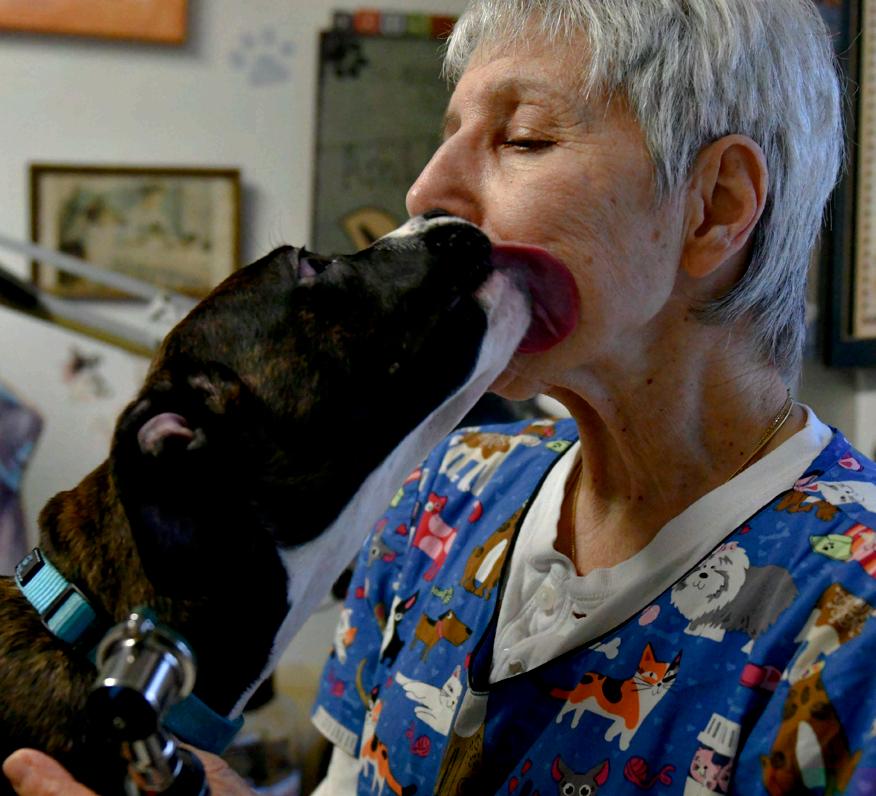
Doering was a longtime fan of dog trainer Cesar Millan when he was still an up-and-coming celebrity. Millan is known for doing the same type of work as Doering on his National Geographic Channel TV show, The Dog Whisperer.
Doering says she believed that Millan would understand the one problem she was still struggling with — connecting to people.
Doering recalls watching his show with her husband, Dave, and thinking, “If I had a week with Millan, I think I could better understand how to continue helping animals’ behavior and not just their obedience training, but help people understand their animals.”
To her surprise, he contacted Millan’s team in 2006 and coordinated a birthday trip where Doering could learn first-hand from her idol. The next thing she knew, she was flying to Los Angeles to spend a week with the dog whisperer.
“It’s not that he taught me animal behavior; I’ve been studying that for years,” Doering says. “It was what he did for me in just one single day. He taught me that I needed to learn more
about myself and how I could work differently with people, how their emotional states affected the animals.”
Doering came back to Missouri and started volunteering with Puppies For Parole, in which selected offenders in Missouri prisons have the opportunity to train rescue dogs.
“It was the most beautiful thing,” Doering says. “I wish everybody could see it and understand how amazing the human-animal bond really is.” She helped write the Puppies For Parole manual that is used in correctional facilities statewide.
As her clinic’s anniversary approaches, Doering says that it has been a gift to work with animals every day over the past 40 years, one that will hopefully keep on giving.
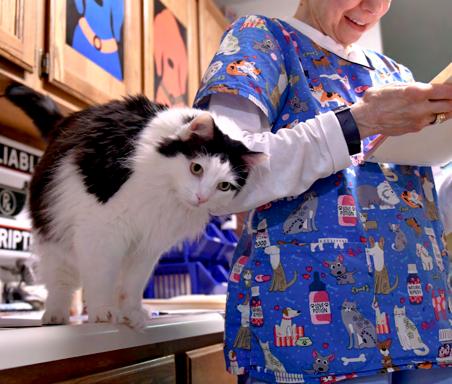
icals,” says Douglas Valentine, a sociology Ph.D. candidate at MU who studies funeral rites. Common practices such as cremation leave a carbon footprint that is equivalent to a 500-mile road trip, according to a 2009 Reuters article.
Although green burial is a more economically and environmentally friendly option than embalming, many funeral homes encourage more expensive practices. For instance, the use of vaults — sealed receptacles that protect the casket from dirt and humidity — and embalming are common funeral practices. Embalming uses chemicals to stall decay so that families can view the body, which the Funeral Consumers Alliance says can be helpful in the grieving process. Still, a 2017 National Funeral Directors Association survey reported that 53.8% of respondents expressed some interest in exploring greener funeral practices.
Instead of choosing a traditional casket to bury their father in, two children came to see Bill Goddard and Chuck Worstell to explore other options. Goddard and Worstell are the owners of Pushing Up Daisies, which is the only service that provides green burials in Columbia. There, the clients chose to hollow an old tree they used to make forts in as kids and buried their father in this unconventional casket.
Green burials are defined by the Green Burial Council as “practices that have minimal impact on the environment.” The green burial practice is gaining popularity after decades of embalming and formal funeral rites. It doesn’t use embalming chemical solutions, vaults or even traditional caskets; it aims to go back to an older, ecological way of taking care of the deceased.
One of the most appealing factors of
green burial is the low cost. A grave site in the Green Acres cemetery on Corporate Lake Drive costs $885. Goddard and Worstell knew they wouldn’t earn a lot when they founded their business, but money wasn’t their main interest. They did it to protect the planet and help families in their time of grief. Goddard jokes with Worstell that their only quota is two cups of coffee. “This is not something we’re doing for the money,” Goddard says.
Goddard and Worstell say their priority is to do no harm. Everything that is put into the ground should be biodegradable. Being part Native American, Goddard says he believes it’s important that he protect the Earth. “We’re stewards of the land,” he says. “We don’t want to mess up the ecosystem.”
With standard burial practices such as embalming, “we’re just burying chem-
We dug up the cost of a green burial from Pushing Up Daisies and some funeral costs from Lincoln Heritage Funeral Advantage, a burial insurance program in 19 states.

Traditional funeral costs
Casket: $845$3,199
Cremation: $1,743
Full funeral: $7,775
Green funeral costs
Grave site: $885
Opening and closing the grave: $600
Coffin: $775
Valentine says holding a viewing and having an open casket are exclusively Western practices. University of Nevada Ph.D candidate Nicholas MacMurray says the industry relies on our anxiety and discomfort with death. Funeral homes alleviate this anxiety by dealing with the transportation and other arrangements — at an additional cost. Americans consider all of these steps to be the norm, and their anxiety prevents them from questioning it. Funeral homes charge anywhere from $8,000 to upwards of $20,000 for their services. “Embalming is not legally mandated; it’s just something that is kind of the cultural norm,” MacMurray says.
The practice of green burial is inhibited by a lack of availability, but another obstacle is a lack of true understanding about what makes it so special.
MacMurray says an important aspect of green burial is that it helps people feel more comfortable with death, which has long been a source of unease in Western culture. “Some people talk about how this is a chance to reclaim death from the professional sphere,” he says.
Whether it is for religious, personal or environmental reasons, some people in the United States are looking for a simpler way to say goodbye to their loved ones while being a little kinder to the planet. Green burial is one way to do that.
This ecologically and economically friendly burial practice is rising in popularity, and it challenges Western culture’s discomfort with death.
This disorder has no cure, but two local experts explain ways to help.



 BY ASHLEY JONES
BY ASHLEY JONES
As many as one in 20 people have serious hoarding problems, according to the International OCD Foundation. TV shows such as A&E’s Hoarders can reinforce the misconception that getting the clutter out of the house completely cures a hoarder, and that is far from the truth, say licensed clinical social worker Beth Orns and social worker and therapist Candice Kundert.
To better understand compulsive hoarding and how to help those with the disorder, Orns and Kundert, who are both based in Columbia, provide some insight into the disorder and steps toward improvement.
What is compulsive hoarding?
Compulsive hoarding disorder is when someone accumulates a lot of items that have little to no value to others. “Most people who do this, I find it, are in a lot of pain,” Kundert says. For some, compulsive hoarding can be concurrent with anxiety or depression. It doesn’t happen overnight. A hoarder starts thinking, “if I let this go, I might need it someday,” and clutter slowly piles up around the house, Orns says.
To an outsider who doesn’t see the home of a hoarder, the disorder can be difficult to identify. Clutter that makes it hard to move through someone’s home is a sign of hoarding.
The International OCD Foundation defines hoarding terms.
Clutter is a disorganized pile of unrelated objects in a space designated for other purposes.
Collecting is keeping valuable or interesting objects in an organized way.
Squalor refers to an unsanitary home.
Do all hoarders keep similar items?
Items vary depending on the root of the problem. If they were neglected in the past, children might hoard food in fear of having nothing to eat. Adults often hoard newspapers, old containers, clothes or anything else that traditionally has no value but that they have built an attachment to.
Why is it hard to part with the items?
Fear. An underlying cause often leads hoarders to feel like a part of themselves is leaving once they build an emotional attachment to those items, Orns says.
What are the repercussions?
Hoarding often makes it impossible to host guests, and never having company can lead to a lack of socialization and a lower quality of life. The house can become a fire and safety hazard, and hygiene and eating habits can be affected if the bathroom or kitchen are inaccessible. Compulsive hoarding can also lead to homelessness due to evictions.

Are hoarding and obsessive-compulsive disorder related?
Yes. They are both obsessive disorders. It’s a stereotype that people who have OCD keep their houses pristine.
“Sometimes that’s true, but you can also
have OCD and be afraid to let anything go or make a decision,” Kundert says. Many people with OCD are not hoarders, but some hoarders also have OCD. The two diagnoses are in the same family.

To find out more on compulsive hoarding and to find local resources, visit hoarding.iocdf.org.


Is there a cure for hoarding?

The short answer is no. However, there are steps and treatments that can help someone who hoards. Counseling is one option. “It’s not going to happen overnight,” Orns says. Medications can help if the disorder is attached to anxiety or depression. Cognitive behavioral therapy or clinical hypnosis are other treatments that might help, Kundert says.

How can I help a hoarding friend or family member de-clutter?
Start small. Let the person know your concerns, and try to help them talk to somebody about the root of the problem. As far as cleaning up, you can begin with a corner of a room and talk through the objects your friend should get rid of. Ask questions to help him or her let go of items: Have you used this in the past year? Does this really give you pleasure, or is it just something sitting here? You are treating the person, not the home, Orns says.
In celebration of the 19th Amendment, MU Theatre presents this adaptation of Elizabeth Robins’ 1906 feminist classic. Directed by Cheryl Black, Votes for Women is a suffragette play with plot twists. March 11–14, 7:30 p.m.; March 15, 2 p.m., Rhynsburger Theatre, $17, $2 discount on tickets purchased at least one week in advance, 882-7529
This lecture series features a panel of fashion industry professionals who review designs by Stephens College students. These professionals include Nasheli J. Oritz, a contestant on Netflix’s Next In Fashion, and fashion designer Johnathan Hayden. March 13, 10 a.m., Stephens College Charters Lecture Hall, free, 442-2211
Join in on the praise and worship with the Liberty Belles. Several singing groups from Missouri, Illinois and Iowa will fill your day with music. Lunch is provided. March 21, 10 a.m., Liberty Baptist Church, free, 881-3990
The Loop and Jabberwocky Studios present their monthly workshops where locals can create and grow their brands. Whether they sell beer or baked goods, these
courses will assist any entrepreneur. April 7, 5:15 p.m., 601 Business Loop 70 W., free, 443-5667
Take a break at Rock Bridge Memorial State Park to learn about invasive plant species. Training will consist of an indoor class session followed by a nature hike where participants can test their new skills.
Ages 12 and up. March 14, 10 a.m. to 3 p.m., free, call to reserve, 564-3476
Put your brain to the test, support local theater and try your luck for prizes at Co -
lumbia Entertainment Company’s Annual Trivia Night. Raffle items include tickets for the Kansas City Royals and St. Louis Cardinals. Gift cards for Pizza Tree, Shakespeare’s and the Heidelberg are available prizes as well. March 27, 6 p.m., doors; 7–10 p.m., Knights of Columbus Hall, $20; $120 for a table of eight, 474-3699
Need to find a gift for a friend’s birthday or want to treat yourself to a little something? The Battle Band Boosters’ Spring Bazaar is the place for you. A variety of vendors will be there, so you’re sure to find something that fits your taste. Admission comes with entry into the door prize raffle. April
Join the local indie-folk duo The Burney Sisters to celebrate the release of their latest EP, Letter to You, and pick up a copy. This is an all-ages show, so bring the whole family. April 3, 9 p.m., Rose Music Hall, $5, 875-0588

4, 9 a.m to 2 p.m., Battle High School, $2, see Battle Band Boosters Spring Bazaar on Facebook for more information
Empty Bowls
Paint a bowl, and get a free meal at the Columbia Center for Urban Agriculture’s Empty Bowls fundraiser. Donations go to Planting for the Pantry, an initiative to grow fresh food for local food pantries. Along with bowl painting and food, there will be live music at dinner and kids activities throughout the event. March 13, lunch 11 a.m. to 1 p.m.; dinner 4–7 p.m, Columbia Agriculture Park’s MU Health Care Pavilion, suggested $5–$20 donation to keep a bowl, 514-4174
Herb Du Vin
Add a little extra flavor to your weekend with the Missouri River Wine Trail’s Herb Du Vin. This tour of seven wineries pairs food and wine under the theme of mid-Missouri herbs. The two-day journey includes food, drinks and a packet of herbs from each winery, as well as a souvenir glass. March 21–22, noon to 6 p.m., $20; $10, designated drivers, 800-690-1830
Jason Aldean: We Back Tour Country superstar Jason Aldean will be returning to
Mizzou Arena as part of his We Back Tour. He’ll be joined by Morgan Wallen, Riley Green and Dee Jay Silver, so plan on going if you want “A Little More Summertime.” March 13, 7 p.m., Mizzou Arena, $46–259, 882-6501


Anthony Worden and the Illiterati with The John Galbraith Trio Rock ’n’ roll act Anthony Worden and the Illiterati will be joined by the John Galbraith Trio after the success of their latest album, Voilá, which was released in February. Drop by, and vibe with the Iowa group’s eclectic discography. March 21, 9 p.m., Cafe Berlin, $5, 441-0400
Canadian folk performer Colter Wall will be stopping by The Blue Note as part of his spring tour. The 24-year-old singer’s latest album, Songs of the Plains, features tunes about his hometown, Saskatchewan, Canada, and his roots. March 28, 9 p.m., The Blue Note, $22, 874-1944

























For two nights only, Missouri Contemporary Ballet presents LIVE!, an exhibition of dance and music. The show features acclaimed works from the MCB repertoire as well as original compositions by local musicians Tom Andes and Travis McFarlane. April 3–4, 7 p.m., Missouri Theatre, $28–48, children’s discount depending on seating, 882-3781









































Join the community in supporting the Concerns of Police Survivors, an organization dedicated to helping Missourians who’ve lost a family member in the line of duty. Registration prices vary, but family deals are available. April 4, 8 a.m., Molly Bowden Memorial Park, $20–40; $100 for a group of four, register at runsignup.com





Bring the whole family, and spend the afternoon under the sky. Awards will be given at the end of the day for highest flyer as well as biggest and smallest kites. Kites will be available for children who don’t have one. April 4, noon to 2 p.m., Douglass Park Ballfield, free



































Nowthere’s a new screening that can catch lung cancer early and could save lives. Talk to your doctor or learn more at
With the right temperature and wind speed, launching a rocket isn’t ... rocket science. It’s not quite Apollo 11, but this rockoon, a hybrid of a balloon and a rocket, needs more helium in order to take flight. Outside of Foremost Dairy Research Center, MU students Edward Ge and Jack Goddard are having trouble sending it airborne. Three hours and five helium tanks later, the rockoon appeared to be afraid of heights and did not take off. Rockoons are cheap and reusable, unlike rockets. They are used by researchers for experiments. On a high note, rockoons might make launching satellites into space more accessible, according to Purdue University.












